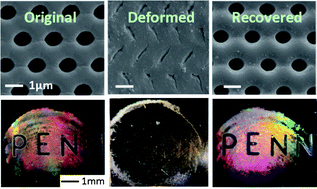Switching periodic membranes via pattern transformation and shape memory effect†
Abstract
We exploited mechanical instability in shape memory

* Corresponding authors
a
Department of Materials Science and Engineering, University of Pennsylvania, 3231 Walnut Street, Philadelphia, PA 19104, USA
E-mail:
shuyang@seas.upenn.edu
Fax: +1-215-573-2128
Tel: +1-215-898-9645
b
School of Engineering and Applied Science, Harvard University, Cambridge, MA 02138, USA
E-mail:
bertoldi@seas.harvard.edu
c Department of Materials Science and Engineering, Cornell University, Bard Hall, Ithaca, NY 14853, USA
We exploited mechanical instability in shape memory

 Please wait while we load your content...
Something went wrong. Try again?
Please wait while we load your content...
Something went wrong. Try again?
J. Li, J. Shim, J. Deng, J. T. B. Overvelde, X. Zhu, K. Bertoldi and S. Yang, Soft Matter, 2012, 8, 10322 DOI: 10.1039/C2SM25816A
To request permission to reproduce material from this article, please go to the Copyright Clearance Center request page.
If you are an author contributing to an RSC publication, you do not need to request permission provided correct acknowledgement is given.
If you are the author of this article, you do not need to request permission to reproduce figures and diagrams provided correct acknowledgement is given. If you want to reproduce the whole article in a third-party publication (excluding your thesis/dissertation for which permission is not required) please go to the Copyright Clearance Center request page.
Read more about how to correctly acknowledge RSC content.
 Fetching data from CrossRef.
Fetching data from CrossRef.
This may take some time to load.
Loading related content
